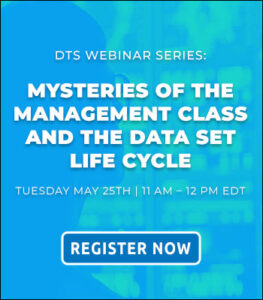In Mysteries of the Storage Class, DTS Software CTO Steve Pryor offered viewers a more thorough understanding of the Storage Class construct, which lies at the heart of System-Managed Storage and specifies whether a dataset is SMS-managed. The two dozen or so attributes that can be specified in the Storage Class indicate what a dataset needs in terms of performance and availability and directly influences the volume selection.
 Since 1989 when DFSMS was introduced, advances in disk technology have rendered some Storage Class attributes obsolete except in very specific circumstances. In the Performance Objectives Category, for example Direct Millisecond Response and Sequential Millisecond Response were formerly important for choosing volumes that were behind a cached controller; today, however, all controllers are cached. As a result, Millisecond Response and Bias are typically used only in class transition, VSAM system-managed buffering, or for PDSE caching. Initial Access Response Seconds isn’t used either, except for OAM datasets or object datasets. Sustained Data Rate (SDR), on the other hand, decides whether or not a dataset will be striped, or grouped across multiple volumes and written in parallel. Provided the dataset in question is an Extended Format (EF) dataset, the number of stripes is simply the value in SDR divided by four.
Since 1989 when DFSMS was introduced, advances in disk technology have rendered some Storage Class attributes obsolete except in very specific circumstances. In the Performance Objectives Category, for example Direct Millisecond Response and Sequential Millisecond Response were formerly important for choosing volumes that were behind a cached controller; today, however, all controllers are cached. As a result, Millisecond Response and Bias are typically used only in class transition, VSAM system-managed buffering, or for PDSE caching. Initial Access Response Seconds isn’t used either, except for OAM datasets or object datasets. Sustained Data Rate (SDR), on the other hand, decides whether or not a dataset will be striped, or grouped across multiple volumes and written in parallel. Provided the dataset in question is an Extended Format (EF) dataset, the number of stripes is simply the value in SDR divided by four.
Watch “Mysteries of the Storage Class” on Demand, Plus Next Week’s Webinar on Management Class
If you weren’t able to attend Mysteries of the Storage Class, you can view it on-demand using this link to hear Pryor go in depth about all the other Storage Class attributes. In DTS Software’s next program, Mysteries of the Management Class and the Dataset Life Cycle, we’ll discuss the Management Class and its unique place in the DFSMS storage management universe controlling the backup, recovery, and availability needs of a dataset. The eight pages of Management Class attributes describe where and how long a dataset “lives,” and are closely related to other storage management components including OAM, disk storage products such as FDRABR and DFSMShsm, and DFSMSrmm tape management. We’ll discuss all of this and more on Tuesday, May 25th at 11:00am ET. You can register here.
On Wednesday, July 14th at 1:00pm EDT, we’ll be back with an event presented by TechChannel and hosted by Pryor along with guest and IBM Champion Reg Harbeck. Aggregation without Aggravation: When Putting More Log Data in Your SIEM is a Good Thing will focus on storage event awareness and why the data from it is a great addition to your SIEM events for better security and compliance visibility. You can register here. We look forward to seeing you at these presentations!


